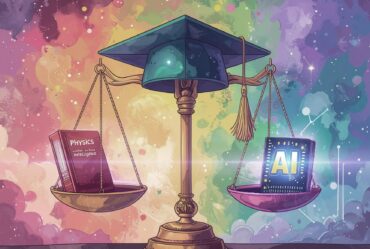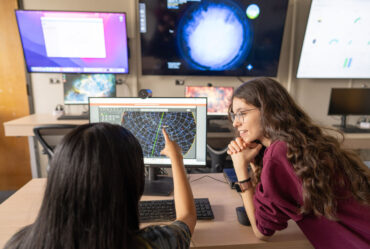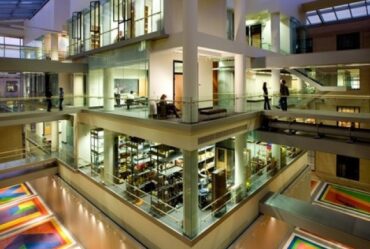
High school students gain skills by working on digital learning materials
MIT Digital Learning Lab and Empowr pilot a new internship program.
For Thomas Esayas, now a high school senior in Texas, the shift to virtual learning in the earlier days of the Covid-19 pandemic provided an opportunity to dive further into his interests in computer science. He started learning the fundamentals of Python and developing projects, such as trying to make a bot that could scour Amazon for computer parts in stock with the goal of ultimately building a computer.
“Once you know the syntax of language, computer science is really just problem-solving,” Esayas says. “I enjoy challenging problems, especially things that require much more consideration than something that takes a lot less time. I like the feeling of doing a challenging thing and overcoming it.”
Esayas’ aspirations to gain iOS development experience led him to Empowr, a program offering computer science training to Black high school students with the goal of providing support throughout students’ entire high school career. After already participating in Empowr for a year, he joined a pilot internship program this past summer, in which two Empowr students worked remotely with MIT Digital Learning Lab (DLL) scientists to create and improve online learning content.
The DLL, a joint program between MIT Open Learning and MIT’s academic departments, is composed of academic staff and postdocs who collaborate on digital learning innovations on campus and beyond. The idea for the internship grew out of a conversation between Empowr Executive Director Adrian Devezin and Mary Ellen Wiltrout PhD ’09, director of blended and online initiatives in MIT’s Department of Biology. They discussed how Empowr might support students by connecting students with high-quality internship opportunities, specially at MIT.
“There were lots of motivations to start this internship program,” says Wiltrout. “The DLL needed extra help, and Empowr had some motivated students wanting coding experience and ready to solve some complicated problems.”
The two interns in this pilot program worked with MIT digital learning scientists across disciplines, including Wiltrout and Darcy Gordon in biology; Alex Shvonski, Michelle Tomasik PhD ’15, and Aidan MacDonagh in physics; and Jessica Sandland ’99, PhD ’04 in materials science and engineering. By working with so many individuals in DLL, the interns were exposed to a wide range of professional projects and learning opportunities. Interns had regular communication with the DLL mentors, with at least one DLL scientist checking in with them every day — with other meetings as needed — in addition to a lot of asynchronous work and checking in via Slack.
“The interns are a lot like MIT students,” says Wiltrout. “Both showed a lot of promise, quickly tackled assignments, and found ways to figure things out on their own when they faced a barrier.”
Specific projects included translating assessment content from Google Docs to the Open edX platform, creating custom XML code for problem or grading functionality in the course running in Open edX, and developing interactive graphs with multiple programming languages. The interns made these contributions within the 7.03.3x (Genetics: Population and Human Traits) course. They gained valuable, hands-on experience in important principles of online content development, including universal design.
“The course I was working on had to feature elements that made it more accessible,” says Esayas. “It opened my eyes to realize you should expand the scope to be more accessible to more people.”
Shvonski worked with the interns on the physics course 8.03x (Vibrations and Waves). Shvonski had developed interactive physics visualizations in Jupyter notebooks but wanted to embed them in web pages more easily, which required that they be rewritten in JavaScript.
“It was an important step to revise the course,” says Shvonski. “Learning how to rewrite these course elements in JavaScript myself would have been time consuming, so the interns made a significant contribution.”
Shvonski implemented the products the interns developed for the fall 2023 semester of Vibrations and Waves, including Esayas’ interactive plot project and other visualizations. “MIT students taking 8.03 have benefited from using these interactive elements this semester,” he says.
Esayas says the internship helped him to understand how computer science skills can be applied across disciplines.
“I like computer science a lot,” he says. “The internship helped me to look at it differently. I see it’s very interdisciplinary. I worked in physics and biology — you can use computer science almost anywhere, like a tool that can be implemented in different places.”
In addition to growing their technical skills, the interns also gained professional experience, learning what it is like to work, report hours, participate in professional conversations and scheduled meetings, and more. The Digital Learning Lab also helped Empowr brainstorm ways to support the other high school juniors in the program, such as trainings on resume writing or what to expect when beginning a job.
MIT Open Learning would like to continue exploring areas for future collaborative efforts with Empowr, says Christopher Capozzola, senior associate dean.
“The interns learned more about themselves and all that they were capable of,” says Shvonski, “and we all learned from each other.”


